Avez-vous déjà essayé d’ouvrir l’une de vos publications WordPress pour être accueilli par une erreur 404 ? C’est parfois le cas lorsque nous travaillons sur nos propres sites WordPress ou lorsque nous aidons nos utilisateurs.
Cette erreur se produit lorsque vous pouvez accéder à votre zone d’administration WordPress et à votre blog, mais que lorsque vous essayez d’ouvrir une publication spécifique, vous obtenez un message “404 Not Found”.
Il peut être frustrant de voir votre contenu disparaître apparemment, mais nous avons trouvé quelques solutions de contournement pour résoudre ce problème. Dans ce guide complet, nous vous montrerons comment réparer les publications WordPress renvoyant des erreurs 404.

Pourquoi mes articles WordPress renvoient-ils une erreur 404 ?
Il y a plusieurs raisons pour lesquelles vos publications peuvent afficher une erreur 404 “Page Not Found” dans WordPress. Il peut s’agir de
- Conflits de plugins ou de thèmes : Parfois, les plugins ou les thèmes que vous avez installés sur votre site peuvent interférer avec la manière dont WordPress gère les permaliens. Cela peut entraîner des liens brisés et des erreurs 404.
- Problèmes liés au code personnalisé : Si vous avez ajouté un code personnalisé à votre site web, il se peut que des erreurs dans le code affectent les permaliens ou provoquent d’autres conflits, ce qui entraîne des erreurs 404 pour vos articles.
- Problèmes avec votre fichier .htaccess : Le fichier .htaccess joue un rôle dans la manière dont WordPress structure les URL. Si ce fichier est corrompu ou manquant, il peut prospecter des erreurs 404 pour vos publications ou vos pages.
Comment trouver toutes les publications WordPress avec des erreurs 404
Avant de passer aux solutions, il serait bon de déterminer si cette erreur ne concerne qu’une ou deux publications ou plusieurs. Vous pourrez ainsi déterminer l’ampleur du problème et choisir la solution la plus appropriée.
Une façon simple de le savoir est d’utiliser Google Search Console. Si vous n’avez pas encore soumis votre site à Google Search Console, lisez notre guide sur l ‘ajout de votre site WordPress à Google Search Console.
Une fois que le robot Google a exploré et indexé votre site, Google Search Console vous fournit des informations détaillées sur les performances de votre site, notamment sur les erreurs 404 qu’il rencontre.
Pour savoir quelles publications renvoient des erreurs 404, vous pouvez vous connecter au tableau de bord de la Search Console. Naviguez ensuite vers le rapport “Pages” et vous obtiendrez une liste détaillée de toutes les erreurs.
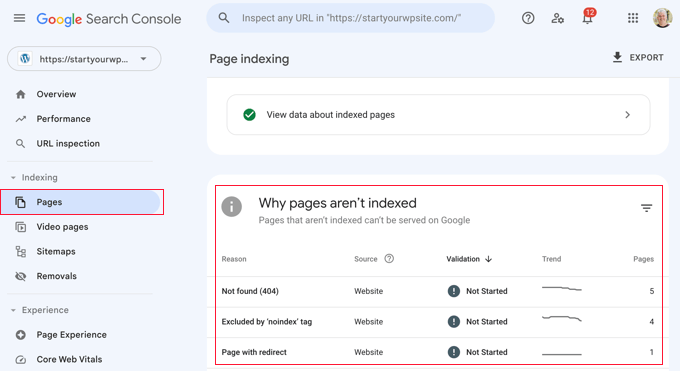
En savoir plus, vous pouvez consulter notre liste de conseils pour utiliser Google Search Console afin d’augmenter le trafic de votre site, qui comprend notamment des astuces pour corriger les erreurs 404 avec l’outil.
Ceci étant dit, voyons comment corriger les publications WordPress renvoyant des erreurs 404. Vous pouvez utiliser les liens ci-dessous pour passer directement aux différentes solutions :
Pas le temps de corriger les erreurs 404 vous-même ? WPBeginner Pro Services peut vous aider ! Avec notre support WordPress d’urgence abordable, vous pouvez embaucher des experts pour réparer les erreurs 404, les liens brisés, les problèmes de redirection, et bien plus encore. Arrêtez de stresser sur les problèmes WordPress et corrigez-les ! Planifiez un support WordPress d’urgence dès aujourd’hui !
Méthode 1 : Vérifier les conflits de plugins ou de thèmes et les problèmes de code personnalisé
Parfois, les extensions, les thèmes ou le code personnalisé que vous avez ajouté à votre site WordPress peuvent interférer avec les permaliens ou provoquer des conflits, prospectant ainsi des erreurs 404. Nous en avons nous-mêmes fait l’expérience lorsque nous testions des outils sur notre site de démonstration.
Une façon de résoudre ce problème est de désactiver temporairement les plugins. Les plugins peuvent parfois perturber la manière dont WordPress gère les liens.
Une fois que vous avez désactivé les plugins, vous pouvez les réactiver un par un en vérifiant si l’erreur 404 réapparaît après l’activation de chaque plugin. Si l’erreur réapparaît après l’activation d’un plugin spécifique, il se peut que ce dernier soit le coupable.
Vous pouvez ensuite effectuer une recherche rapide sur Google pour trouver des solutions liées à cette extension ou contacter le développeur de l’extension pour obtenir de l’aide.
De même, votre thème WordPress peut être à l’origine du conflit.
Pour vérifier, vous pouvez temporairement passer à un thème WordPress par défaut comme Twenty Twenty-Three ou Twenty Twenty-Four. Tout ce que vous avez à faire est d’aller dans Apparence “ Thèmes et de cliquer sur “Activer” sur un thème par défaut.

Si l’erreur 404 disparaît avec le thème par défaut, cela indique un conflit potentiel avec votre thème actuel. Vous pouvez alors essayer de dépanner le thème ou envisager d’utiliser un autre thème.
Vous pouvez consulter notre sélection de thèmes WordPress les plus populaires pour obtenir des recommandations.
Si vous avez récemment inséré des extraits de code sur votre site web, il se peut que des erreurs dans le code soient à l’origine des erreurs 404. Examinez attentivement le code que vous avez ajouté et voyez si vous pouvez identifier des erreurs.
Le moyen le plus sûr d’ajouter des extraits de code à WordPress est le plugin WPCode. Ce plugin vous permet d’insérer du code personnalisé sans travailler directement avec les fichiers du thème, ce qui réduit le risque de briser votre site web.
De plus, lorsque WPCode détecte une erreur dans votre code, il désactive automatiquement l’extrait et vous demande de le vérifier. Vous pouvez également utiliser le mode de test pour vérifier que votre code fonctionne avant de le transférer sur votre site web.

Si aucune de ces solutions ne fonctionne, passez à la méthode suivante, qui vous permettra de résoudre les problèmes liés aux paramètres des permaliens.
Méthode 2 : Corrigez les paramètres de votre Permalink
Les publications WordPress peuvent renvoyer des erreurs 404 en raison de problèmes liés aux règles de réécriture dans votre fichier .htaccess. Dans la plupart des cas, vous pouvez corriger le problème en mettant à jour vos Réglages permaliens.
Il suffit d’aller dans Réglages ” Permaliens dans votre administration WordPress, et de cliquer sur le bouton ” Enregistrer les modifications “.

Il n’est pas nécessaire d’apporter des modifications aux réglages permaliens eux-mêmes. Cela mettra à jour vos réglages permaliens et effacera les règles de réécriture.
Dans la plupart des cas, cette solution corrige l’erreur 404 des publications WordPress. Cependant, si cela ne fonctionne pas, vous devez probablement mettre à jour votre fichier .htaccess manuellement.
Méthode 3 : Mettre à jour le fichier .htaccess de WordPress
Avant de commencer, veillez à sauvegarder le fichier .htaccess de WordPress. En cas de problème, vous pourrez facilement restaurer le fichier d’origine.
Vous devez maintenant vous connecter à votre serveur à l’aide d’un client FTP tel que FileZilla ou de l’application Gestionnaire de fichiers du tableau de bord de votre hébergeur WordPress.
Ensuite, vous devrez trouver et modifier le fichier .htaccess, qui se trouve au même endroit que des dossiers comme /wp-content/ et /wp-includes/.
Il suffit de cliquer avec le bouton droit de la souris sur le fichier et de sélectionner “Droits du fichier”.
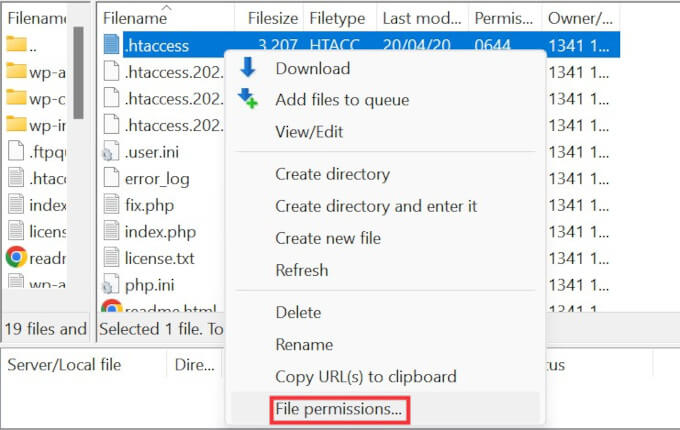
Vous pouvez rendre le fichier accessible en écriture en modifiant ses droits à 666.
Saisissez simplement “666” dans la case “Valeur numérique” et cliquez sur “OK”.

Ensuite, vous devez répéter les étapes de la première méthode de notre tutoriel. Une fois que vous avez fait cela, n’oubliez pas de modifier les droits pour revenir à 660.
Vous pouvez également modifier le fichier et y ajouter du code.
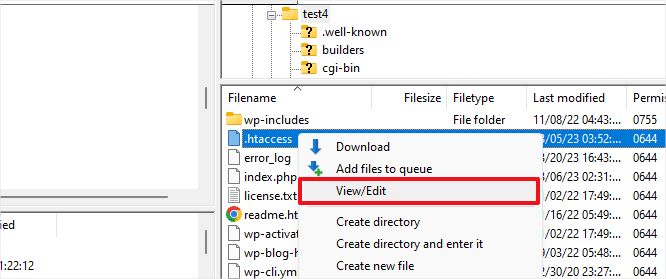
Une fois que vous avez ouvert le fichier .htaccess avec un éditeur/éditrices de texte, insérez simplement ce code :
# BEGIN WordPress
<IfModule mod_rewrite.c>
RewriteEngine On
RewriteBase /
RewriteRule ^index\.php$ - [L]
RewriteCond %{REQUEST_FILENAME} !-f
RewriteCond %{REQUEST_FILENAME} !-d
RewriteRule . /index.php [L]
</IfModule>
# END WordPress
Méthode 4 : Contactez votre fournisseur d’hébergement
Si aucune des solutions ci-dessus n’a corrigé l’erreur WordPress posts returning 404, nous vous recommandons de contacter votre fournisseur d’hébergement WordPress. Il se peut qu’il y ait une erreur de leur côté, ou ils pourraient être en mesure de vous aider à dépanner le problème.
Veuillez également consulter notre guide sur la manière de demander correctement un support WordPress et de l’obtenir.
Méthode 5 : Activer mod-rewrite (Installation locale de WordPress)
Si vous utilisez un serveur local à des fins de test, vous devrez activer mod_rewrite dans la configuration Apache de votre site MAMP, WAMP ou XAMPP.
Cela permettra à WordPress de générer des URL propres et d’éviter l’erreur 404 pour les publications et les pages sur votre serveur local.
La manière de procéder diffère selon la plateforme utilisée. Les personnes qui utilisent XAMPP peuvent ouvrir leur panneau de contrôle et cliquer sur le bouton ‘Config’ dans Actions. Sélectionnez ensuite “Apache (httpd.conf)”.
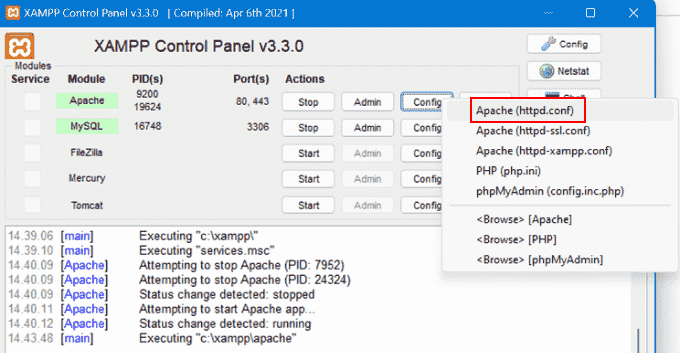
Ensuite, vous devrez trouver cette ligne #LoadModule rewrite_module modules/mod_rewrite.so et retirer le ‘#’ pour la décommenter.
Ceci chargera le mod_rewrite.
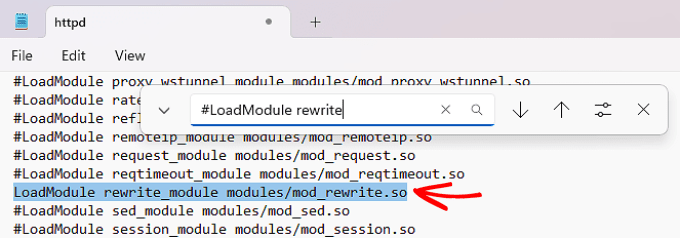
Ensuite, trouvez toutes les instances de AllowOverride None et modifiez-les en AllowOverride All.
La valeur “Tous” signifie que toutes les directives peuvent être remplacées.

Une fois cela fait, vous pouvez enregistrer le fichier httpd.conf et le fermer. Ensuite, dans le panneau de contrôle XAMPP, cliquez sur “Stop” sur le module Apache et sur “Start” à nouveau pour le redémarrer.
Ensuite, retournez dans votre Tableau de bord pour voir si vos permaliens fonctionnent.
Tutoriel vidéo
Si vous avez besoin d’instructions visuelles, regardez la vidéo ci-dessous.
Nous espérons que cet article vous a aidé à résoudre les publications renvoyant des erreurs 404 sur WordPress. Vous pouvez également consulter notre guide des erreurs WordPress les plus courantes et comment les résoudre, ainsi que nos choix d’experts pour les meilleures extensions WordPress pour développer votre site.
Si vous avez aimé cet article, veuillez alors vous abonner à notre chaîne YouTube pour obtenir des tutoriels vidéo sur WordPress. Vous pouvez également nous trouver sur Twitter et Facebook.





Rj
thanks man u saved my life
Phannipha
Thank you for very useful sharing. Just only one click can solve the problem:)
Ehiz Mikey
A million thanks Syed. I was stuck here for a couple of weeks. A fix indeed.
Kaycee
Hi. Really nice article.
I had a 500 internal server error issue with my site when I tried using the W3 Total Cache plugin.
To fix this, I renamed the .htaccess file to .htaccessbak. After doing this, I noticed that the 500 error cleared but then I got a 404 error! All the links and pages on my site returned a 404.
On the All Pages section, I see a link that says “Purge from cache”
Please what do I do to clear this issue?
Stanley
You’re a life saver, worked for me.
Really grateful,
Thank you
syed
thanks it works for me….
Christian Fraunholz
but why is that happening and how to fix it forever?
Karma
I tried to follow your direction in fixing my problem, it took for about a day, but I didn’t find the good result.
Then I gave up and contacted my hosting. And it fixed only in 5 minutes. Lol the problem came from the hosting…
Mark Kay
By careful with post variables names. I had a contact form with an input field called “name”, that caused WordPress to show the 404 page. Took me a long time to figure out the problem. I fixed it be changing the field name from “name” to “your-name”.
Ivan
thanks you saved my life.
Ramzan
My problem is that I m going to wp adminin
And want to edit post it is not going in edit mode of post and page gives me error page not found 404 but my site and its pages are opening well in browser
Plz guide me I can solve this problem
Ben
Samo rpoblem here. Cannot edit the existing posts or add new one. I get 404 for both
Sunit
Hi, I have tried following the above steps but my issue is this: when I visit my website directly by putting typing the url, then it works fine. But, when i type in my site url in google search box and then click on the link from the search results, I get the 404 error or message saying “your connection is not private”.
My website is http://www.example.com but google search result shows it as https://example.com/
So not sure what the issue is. I used to have wordpress.com but now I am dong self-host using HG.
Any help will be appreciated.
Thanks
WPBeginner Support
www is considered a subdomain of a domain. So basically a site with www and without www will be considered two different sites by search engines. Go to Settings > General page to change your site URL from http://www.example.com to just example.com.
WordPress.com enabled https for all custom domains on WordPress.com. This means Google had already crawled your website with https in the URL. You can install free https using Let’s Encrypt.
Administrateur
Paul Nicholson
Great worked for me thanks!!
Shashdhar S
Thanks a lot , the second option worked for me ….. Thank you so muich
eliana
Just THANK YOU!
eli
WPBeginner Support
You are welcome Don’t forget to follow us on Twitter for more WordPress tips.
Don’t forget to follow us on Twitter for more WordPress tips.
Administrateur
Michaela
hi, I tried first solution, nothing happened. I wanted to try the second, but I cannot find the .htaccess file. Not in FTP, not even in my WP online editor. I had this issue today for the first time. I use WPML plugin, until now everything went without problem, but today my translated post in English throws this 404 Error. Any idea what shall I do if I cannot locate the .htaccess file?
Thanks!
Michaela
I noticed one thing. The post in the editor shows me the following link:
example.com/2016/09/15/where-eat-in-barcelona/?lang=en
but when I click to see the post, or from any RSS feed click on the published post, the link showing 404 error is as follows:
example.com/?p=11409&lang=en
WPBeginner Support
Please take a look at our guide on why you can’t find .htaccess file on your WordPress site.
Administrateur
Shirish Dhungel
Well thanks! I remember, that WP Super Cache official stated to remove rewrite code from .htaccess. After that, my posts redirected to 404. Thanks to you, now my site is perfectly fine.
Muhammad Nasir
Thanks it worked for me, thank you so much.
Akhelesh
Do I have to remove the code snippet I added to htacces file after my problem has been solved?
Jessica
Can someone contact me please? I am so new to these I don’t even know what a FTP server is…
WPBeginner Support
Please see our guide on using FTP.
Administrateur
Rohan khamkar
Sir, when I post a new post it gives me error that 404 page not found. Previously everything was fine but when I add a new user and give him a role of administrator from that time I can’t post new post. Any solution Please. Thank you in advance.
WPBeginner Support
You should never give administrator role to a user you don’t trust. You can always change back their role by going to Users page and then clicking on the Edit link below the user that you want to change. After that you check your site’s permalink structure. See if they installed any new plugin and if they did, then deactivate that plugin.
Administrateur
Shivani Sehdev
Wow……….. Solved a long ago problem .
Thanks A lot.
R Donahoo
Didn’t work on my apache server. Had an additional step to allow mod_rewrite to actually work. Edit your httpd.conf file and add ‘Allowoverride all’. For example:
DocumentRoot /var/www
find the section that sets up the directory options, such as:
Options Indexes FollowSymLinks MultiViews
Order allow,deny
allow from all
add Allowoverride all
Options Indexes FollowSymLinks MultiViews
AllowOverride all
Order allow,deny
allow from all
save and restart the web server to re-read the updated configuration.
All was well after that.
Thanks for your useful post moving me into the right direction.
Arnaud
forgot about htis #yaDaMan
Ben
Didn’t work for me either
Where can I find this file you are talking about
aderele olutayo samuel
this worked. …. Thanks
Eva
I found the some problem. However, I could not log in to the admin page. Could you give solution to mitigate this problem?
Rodrick Green
This was very easy and very helpful. THANKS A LOT!!!
B Pandey
thanks for your usefull tip. It worked for me on my website. Thanks a lot
sheldon
Thank you .
It worked for me
Rachit Sharma
but not working for me when i updated permalink with post name and change .htcces file but not worked. any other solution for that.
Ahsan
Wowww Thank you so much, that was really helpful.
In my case it was WAMP server, after turning on “rewrite module” in apache, my problem was solved.
Thanks.
Kailash
Wow – this still works. Done a search on google and found articles in wordpress but this was by far the simple-est and bang it works.
Thanks a mill – saved me a heap of time
WPBeginner Support
Glad you found it helpful.
Administrateur
Shawn Ritch
Hello and thanks for all the useful tips. Unfortunately, this tip didn’t work for me. I re-saved my permalinks in WordPress settings (didn’t work) so then I tried your next method and it didn’t work either. I’m thinking the reason for this is because I have different permissions. My original permission is 644. When I change permission to 660 none of my pages work so I believe the 666 permission is wrong as well. I’m using a Go Daddy server if that helps any :/
I’m at a loss and have no idea what to do from here. However, I can’t afford to have pages that don’t work. Any suggestions would be greatly appreciated.
Thanks
Shawn Ritch
Kevin Garcia
I tried this and it didn’t help me!!! My whole website crashed and had to restore it!!
Hannah Brown
Thanks, yours was the only place that told me HOW to fix my broken links! You’re the best
WPBeginner Support
Glad you found it helpful.
Administrateur
Kunal Yande
Thanks !!
You save my so much time….
Chris
How do I fix the issue when I upload a new plugin and then my categories, not posts, become 404?
Bob
This is great advice. I thought I was going to have to take a deep dive, but two clicks and I’m GTG. Thanks!
Ronn Reason
hi
i keep getting this message with my email account;
Error Oops… a server error occurred and your email was not saved. (#404)
Please advise ASAP
Gabo
O.O
I can’t belive this …. it works, thanks !!!!!
Steve
I had this problem after moving sites to a new server. Default Permalinks worked, but not the settings I was using.
I needed the apache server to “Allow Override” for the htaccess file to take effect.
Vivek
Hi,
I need a little help regarding 404 error.
I am getting 404 error in my Page 2 section.
I have googled a couple of times. but did not get the solution.
Could you please tell me what is the reason for it?
Rudy
My site links will work ONLY after I’ve VIEWED the permalink settings, without any changes, and Voila! The links work again. What is causing this and how can I program this instead of having to log in?
I’ve tried the following commands in WP-CLI to no avail:
wp rewrite flush –hard –path=c:\xampp\htdocs\mywordpress
wp cache flush –path=c:\xampp\htdocs\mywordpress
Amit Schandillia
This saved my life!!!!!
Patrick
Thanks man, just pressing the “Save changes” on the permalink-settings page did it for me! Cheers!
Amanda
Hi there,
About an hour ago I was able to remedy a pesky ‘500 Internal Service Error’ by following your sage advice and renaming the .htaccess file to .htaccess_old. I was immediately able to access my wp-admin area–and I thought–get going again.
Unfortunately, something happened which rendered all of my other pages unfindable; each kicking a 404 error.
I attempted the steps you provided above, but to no avail. Might you have any further suggestions?
Thank you.
Jessa
You guys are awesome, this was easy and fast. You guys save me a trouble!
mehdi
why i coudl not see my post?
after I send a post my preveous posts appear.
it made me crazy please remove previous post
…
I found a solution to my problem and will say in next post
mehdi
Hello agin
thank you for this useful article/ I found a bug in wordpress in rtl language in displaying permalink
I read your article and encourage to solve the problem with your contribute.
——————————————
my problem in detail:
1-I created a mysql database(in utf8 general ci)
2-I installed last wordpress versin(locally) and install my theme(multiup v 1.2 from themeforst)
3-Next I did import demo as whele.
in the theme admin panel exixst category portfolio (in this section we create our category with name and slug) then in all post under portfolio section we can create our posts and determine category of post from portfolio category) finally in homepage we have a section that shows portfolio post in category(with their picture)
In english slug and name the category of portfolio show well but when i change category in portfolio category( slug) into rtl language the category in homepage canvert into charachter like base 64(I think that my slug convert into ansi ie each character convert into 6 charachter)
How I can overcome my problem?I think I must avoid change slug or show slug into utf8 or unicode . I am beginer in wpordpress , If I khnew wordpress more I could solve this simple problem .Any one with khnowledge of handling hoock and filter and plugin and wordpress can solve this permalink problem . I sure I will solve this problem with your help.
———————————-
I tried the second way you offer (that phpmyadmin in utf8generalci) but it doee not work for me.
before thansk a lot for helping me.I followed your posts regularly .
……………………………….
1- first I did the trick in above article (this is so good but didnot solve my problem)
2-
mehdi
hello
thanks to contribute you knowledge to others .my english is not well.excuse me.
I download a wordpress theme with portfolio link in admin panel that in porftoli section we can define some category with name and slug . in post we can determine category from portfolio.
in homepage we can display post in portfolio category! all thing is ok but wen i chang name and slug into rtl language the title of a group in home page shows like this %d8%a8%d8%b1%d9%86%d8%af%d8%b3%d8%a7%d8%b2%db%8c
i did your solution in this topic and that another topic(How To Enable Custom Permalinks) but not woks for my problem!
WPBeginner Support
This could happen if your WordPress database is not using UTF-8 character encoding. Please make sure that your database is using utf8_general_ci as collation. You can check that using phpMyAdmin from cpanel. Before you make any changes to your database, please create a complete WordPress backup first.
Administrateur
Atula Gupta
Thank you so much for fixing my problem in seconds! I was panicking about all my posts giving this error and this solution was so simple! Thanks again.
Sammy
Thank you, thank you! This was making me crazy and you just helped me fix it in 2 seconds. High five.